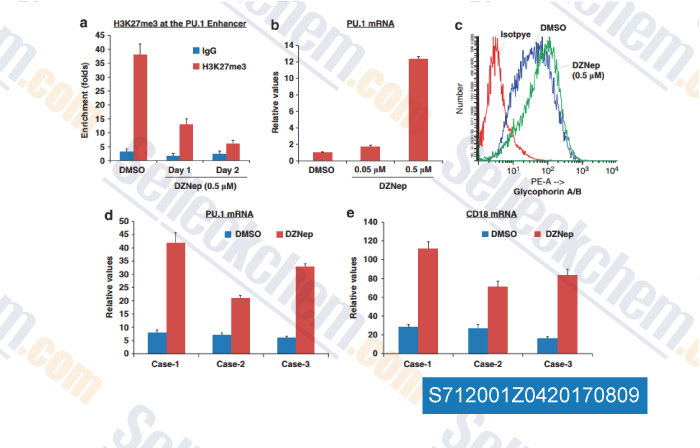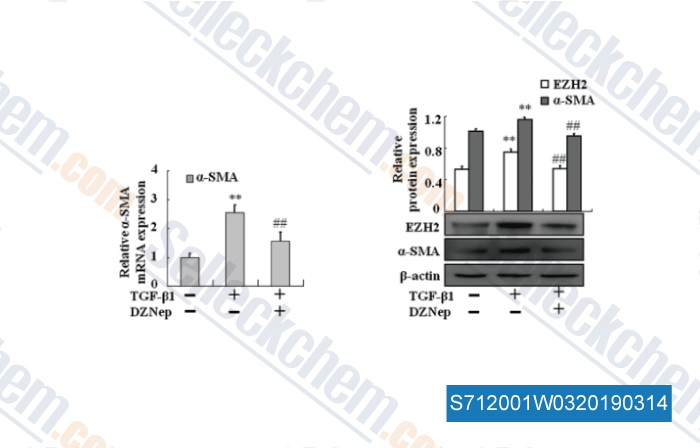|
Toll Free: (877) 796-6397 -- USA and Canada only -- |
Fax: +1-832-582-8590 Orders: +1-832-582-8158 |
Tech Support: +1-832-582-8158 Ext:3 Please provide your Order Number in the email. |
Technical Data
| Formula | C12H14N4O3.HCl |
||||||
| Molecular Weight | 298.73 | CAS No. | 120964-45-6 | ||||
| Solubility (25°C)* | In vitro | DMSO | 52 mg/mL (174.07 mM) | ||||
| Water | 52 mg/mL (174.07 mM) | ||||||
| Ethanol | Insoluble | ||||||
| In vivo (Add solvents to the product individually and in order) |
|
||||||
|
* <1 mg/ml means slightly soluble or insoluble. * Please note that Selleck tests the solubility of all compounds in-house, and the actual solubility may differ slightly from published values. This is normal and is due to slight batch-to-batch variations. * Room temperature shipping (Stability testing shows this product can be shipped without any cooling measures.) |
|||||||
Preparing Stock Solutions
Biological Activity
| Description | DZNeP (3-deazaneplanocin A) HCl, an analog of adenosine, is a competitive inhibitor of S-adenosylhomocysteine hydrolase with Ki of 50 pM in a cell-free assay. | ||
|---|---|---|---|
| Targets |
|
||
| In vitro | 3-Deazaneplanocin A (1.0 μM) results in a significant increase in accumulation of cells in the G0/G1 phase (58.5%) with a concomitant decrease in the number of cells in S phase (35.2%) and G2/M phases (6.3%) of the cell cycle of human acute myeloid leukemia OCI-AML3 cells. 3-Deazaneplanocin A (1.0 μM) induces apoptosis in OCI-AML3 (~50%) and HL-60 cells (~50%), and a more than 90% reduction in colony growth at 48 hr. 3-Deazaneplanocin A depletes EZH2 levels, and inhibits trimethylation of lysine 27 on histone H3 in the HL-60 and OCI-AML3 cells and in primary AML cells. 3-Deazaneplanocin A treatment induces p16, p21, p27, and FBXO32 while depleting cyclin E and HOXA9 levels. 500 nM 3-Deazaneplanocin A induces differentiation of HL-60 to CD11b+ cell by nearly 3-folds time at 48 h. [2] 3-Deazaneplanocin A has excellent activity against several viral types. 3-Deazaneplanocin A is activity against vesicular stomatitis in L929 cells, parainfluenza 3 in H.Ep-2, vaccinia and yellow fever viruses in vero cells with IC50 of 0.2, 3.6, 2.1 and 2.9 μg/mL, respectively. [3] 3-Deazaneplanocin A displays a strongly and uniformly leishmanistatic effect on American Leishmania (L mexicana and L brasiliensis) strains in the study with average ID50 of 96 ng/mL, but shows no inhibition against the several T. cruzi and T. rangeli strains tested with concentrations up to 10 μg/mL. At a dose of 200 ng/mL, 3-Deazaneplanocin A inhibits S-adenosyl-L-3H-methylmethionine and 3-thymidine incorporation by promastigotes after four days. At a dose of 100 ng/mL, 3-Deazaneplanocin A eliminates approximately 56% of the L mexicana and L brasiliensis from infected human macrophages. [4] |
||
| In vivo | 3-Deazaneplanocin A shows antileukemia activity in vivo. 3-Deazaneplanocin A at the doses of 8 mg/kg shows in vivo antiviral activity against vaccinia virus in a mouse tailpox assay with median of 0.0 poxftail (84% protection). [3] 3-Deazaneplanocin A at the doses ranging from 0.5 to 1.5 mg/kg/day, significantly reduced development of cutaneous leishmanial infection produced in inbred BALB/c mice by L. b. guyanensis inoculation. [4] 3-Deazaneplanocin A induces massively increased interferon-α production in Ebola virus-infected mice. 3-Deazaneplanocin A (s.c. injection of 2 mg/kg postinfection) prevents death in mice infected with 1000 pfu (30 000 LD50) of mouse-adapted EBO-Z. Treatment with 3-Deazaneplanocin A on day 1 reduces mean serum viral titers on day 2 by 100-fold and on day 3 by 100 000-fold, compared with placebo controls, and results in a mean serum IFN-α level of 1420 pg/mL on day 2 and 1830 pg/mL on day 3. [5] |
||
| Features | Carbocyclic analog of adenosine, and acts as anti-tumor and anti-virus inhibitor of EZH2. |
Protocol (from reference)
| Kinase Assay: |
|
|---|---|
| Cell Assay: |
|
| Animal Study: |
|
References
|
Customer Product Validation

-
Data from [ , , Leukemia, 2013, 1291-1300 ]

-
Data from [ , , Cell Death Dis, 2018, 9(11):1067 ]

-
Data from [ , , Oncotarget, 2016, 7(10):11194-207 ]

-
Data from [ , , J Cell Mol Med, 2017, 21(10):2317-2328 ]
Selleck's DZNeP (3-deazaneplanocin A) HCl has been cited by 96 publications
| Epigenetic modifiers to treat retinal degenerative diseases [ bioRxiv, 2025, 2025.05.22.655558] | PubMed: 40501782 |
| [C6TSEDRVAJZ, a combination of small-molecule compounds, induces differentiation of human placental fibroblasts into epithelioid cells in vitro] [ Nan Fang Yi Ke Da Xue Xue Bao, 2025, 45(2):322-330] | PubMed: 40031976 |
| Key epigenetic and signaling factors in the formation and maintenance of the blood-brain barrier [ Elife, 2024, 12RP86978] | PubMed: 39670988 |
| Transposable element activity captures human pluripotent cell states [ EMBO Rep, 2024, 10.1038/s44319-024-00343-y] | PubMed: 39668246 |
| Enhancer of Zeste Homolog 2 Inhibition Induces HLA Class I Re-Expression in Merkel Cell Carcinoma [ J Invest Dermatol, 2024, 144(6):1398-1401.e1.] | PubMed: 38052265 |
| Perinuclear assembly of vimentin intermediate filaments induces cancer cell nuclear dysmorphia [ J Biol Chem, 2024, 300(12):107981] | PubMed: 39542246 |
| Activation of the CCL22/CCR4 causing EMT process remodeling under EZH2-mediated epigenetic regulation in cervical carcinoma [ J Cancer, 2024, 15(19):6299-6314] | PubMed: 39513112 |
| Genome-wide identification of histone lysine methyltransferases and their implications in the epigenetic regulation of eggshell formation-related genes in a trematode parasite Clonorchis sinensis [ Parasites Hosts Dis, 2024, 62(1):98-116] | PubMed: 38443774 |
| EZH2 mediated metabolic rewiring promotes tumor growth independently of histone methyltransferase activity in ovarian cancer [ Mol Cancer, 2023, 22(1):85] | PubMed: 37210576 |
| Generation of a humanized mesonephros in pigs from induced pluripotent stem cells via embryo complementation [ Cell Stem Cell, 2023, 30(9):1235-1245.e6] | PubMed: 37683604 |
RETURN POLICY
Selleck Chemical’s Unconditional Return Policy ensures a smooth online shopping experience for our customers. If you are in any way unsatisfied with your purchase, you may return any item(s) within 7 days of receiving it. In the event of product quality issues, either protocol related or product related problems, you may return any item(s) within 365 days from the original purchase date. Please follow the instructions below when returning products.
SHIPPING AND STORAGE
Selleck products are transported at room temperature. If you receive the product at room temperature, please rest assured, the Selleck Quality Inspection Department has conducted experiments to verify that the normal temperature placement of one month will not affect the biological activity of powder products. After collecting, please store the product according to the requirements described in the datasheet. Most Selleck products are stable under the recommended conditions.
NOT FOR HUMAN, VETERINARY DIAGNOSTIC OR THERAPEUTIC USE.
